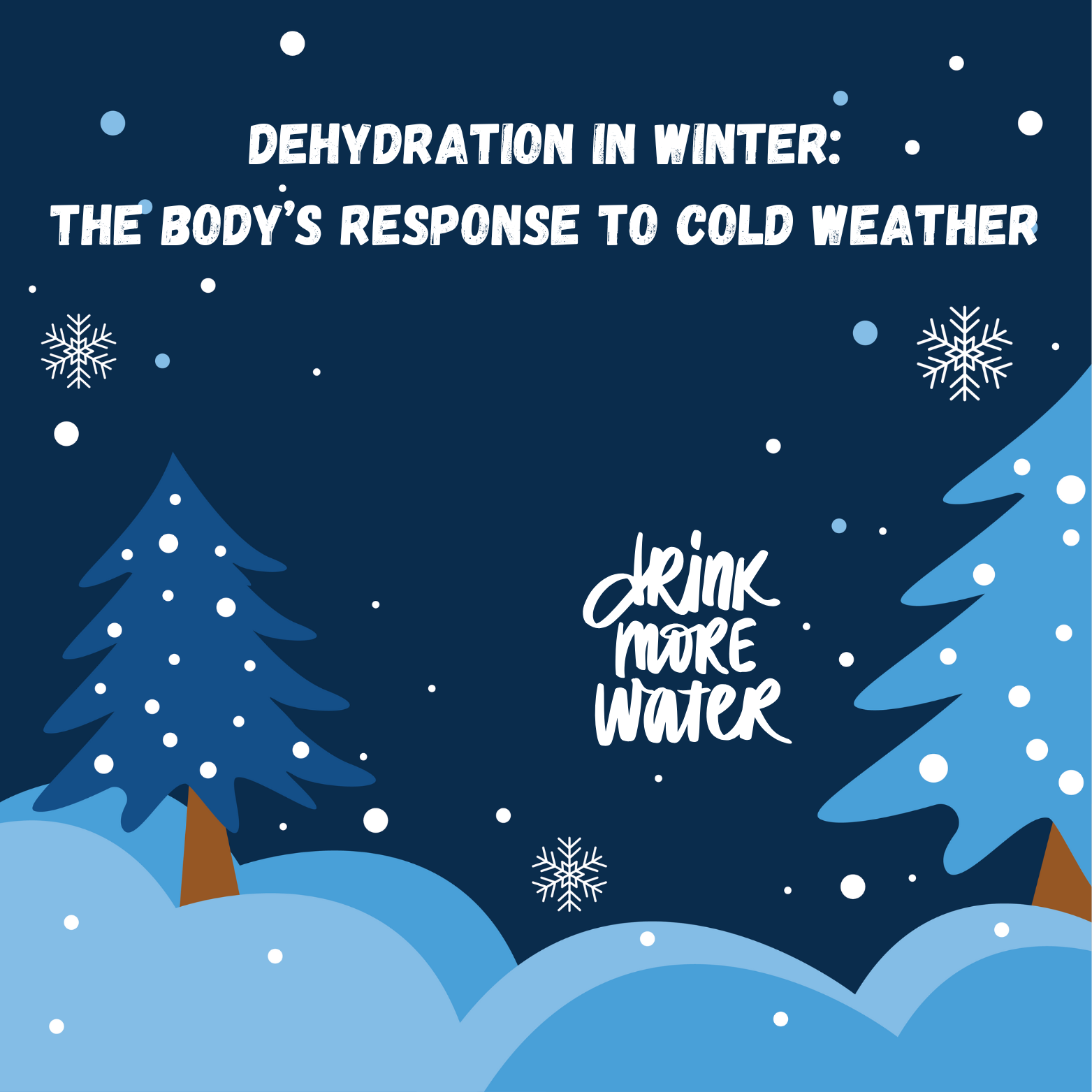Dehydration in Winter

Cold weather negatively impacts the hydration status of the body. Physiological responses to colder weather worsen the impact on hydration status. When exposed to cold weather, the first response is with cold receptors of the skin which causes the feeling of being cold and stimulates the sympathetic, or fight-or-flight, nervous system. The stimulation of these sensors, regardless of hot or cold conditions, subsequently stimulates the hypothalamus which further regulates heat production and loss. The sympathetic nervous system then kicks off the thermoregulatory process to warm the body with two (2) primary physiological responses, called thermoeffector response: peripheral vasoconstriction and shivering.⁵
Peripheral vasoconstriction is the reduction in blood flow to the skin, arm and legs to focus on maintaining warmth within the torso and organs. This reduction in skin and extremity (arms and legs) blood flow results in an increase of more than 300% thermal insulation of the tissues below the skin.⁵ This leads to an improvement in heat retention, improving the ability to maintain proper body heat.
Shivering is a muscular response to colder weather. Shivering is the collection of involuntary muscular contractions where ATP is hydrolyzed and no work is done.¹² This essentially means the body produces heat from small contractions. This heat, at its peak, can increase heat production up to five (5) times the basal metabolic rate, or baseline metabolism.¹² The closer the severity of the shivering gets to peak, the energy source changes from lipids, or fats, into carbohydrates. In continuous, low intensity shivering, the primary energy source is lipids. As shivering increases in severity with temperature decreases, the energy source changes into carbohydrates.⁵
With the combined efforts of peripheral vasoconstriction to retain heat and shivering to produce heat, our body has a built-in response to combat the impact of colder weather, These thermoeffector responses to colder weather have some unintended side effects to the body’s hydration status. Along with the body’s physiological responses, other external factors specific to cold, winter months also exacerbate dehydration.
Below is a list of four (4) different ways hydration status is impacted in colder weather.
1. Thirst Cues are Reduced
A 2004 study revealed that thirst cues are attenuated by up to 40% during cold air exposure at rest and during moderate-intensity exercise.¹³ One potential conclusion from this study is that peripheral vasoconstriction is potentially responsible for the reduction in thirst cues. Since blood has been pulled from the skin and extremities into the central body for heat retention, this leads to the body feeling more hydrated than it truly is. Interesting enough, a different study performed in 2013 found similar results when the test subjects consumed more water during a workout in warmer versus colder conditions.⁶ Since thirst is blunted during colder weather, remaining hydrated becomes more difficult.
2. The Body Produces More Urine
According to the same 2013 study where the test subjects consumed less water, and tended to urinate more during that same time period.⁶ Not only are thirst cues reduced up to 40% as stated previously, this is now compounded with an increase in urine production during cold weather. This is due to a phenomena known as cold-induced diuresis.⁷ The likely culprit is peripheral viscosity, reducing blood flow to the skin and extremities increases blood pressure by keeping blood more centralized. The rise in blood pressure means the kidneys have more blood to filter than normal, producing more urine.² As a result, your body tends to excrete more urine in colder weather.
3. The Body May Sweat More
During winter, there are various reasons for an increase in sweat production despite the colder weather. For starters, the external environment itself. In a cold environment, the initial responses to warm the body up can cause sweating. Adding further complications is the quick shift in temperature from cold, outdoor temperatures to warm, indoor environments confusing the body’s internal thermostat. The second reason is clothing. In winter, clothing strategies to stay warm include adding layers or using warm fabrics such as wool, nylon and synthetic blends. These clothing strategies work for, but also against the intended purposes. Wearing additional layers without the flexibility of easy removal can cause an increase in heat retention without proper air flow or ability to cooldown. The same can be said for the different fabric options as they can also cause sweating. Two wildcards to add in are stress and illness. Both of these are involuntary responses that can lead to either sweating from stress, nerves or illness.
4. Air has a Negative Impact
The cold, winter air has low humidity, and pulls residual moisture from surrounding areas into the air, including from the body. The instant impact is that moisture pulled from the body evaporates instantly, so there is no sweat feeling like in warmer weather. On the flipside, dry air from indoor heating has a tendency to burn moisture out of the air, causing the indoor air to also dry out.¹¹ Whether inside or outside, the air tends to dry out the body in various ways. Beginning with the mouth and nose, resulting dryness increases the risk for nosebleeds, colds, sinus infections and the flu. Next up, dry, cold air can cause itchy, flaky skin, and dry, cracked lips. Cold, winter air and air from indoor heating dehydrates the body, which can reduce the body’s natural ability to fight illnesses and for thermoregulation.
Considering how stacked the odds are to remain hydrated during the cold, winter months, below is a list of a few signs and symptoms of dehydration to look out for:
Dark Urine or Constipation.
Dry, Itchy Skin and Chapped Lips.
Feeling Lightheaded or Dizzy.
Inability to Think or Concentrate.
Poor Appetite.
Remaining aware of hydration status is important for remaining healthy during the winter months. For a minimum hydration standard, aim to consume half body weight (lbs) of water (oz) per day.⁴ For example, a 200 lb athlete should aim for a minimum of 100 oz of water per day, likely more in the winter. Below are ten (10) tips to remain hydrated and avoid some of the negative side effects of dehydration during the cold, winter months:
Drink Water. Consume sufficient daily water intake with electrolytes such as sodium, magnesium and potassium.
Consume Hydrative Foods. With at least 20% of daily fluids coming from foods, consuming more soup, fruits and vegetables can improve overall hydration.¹
Moisturize. Keep skin and lips moisturized to prevent dry, itchy skin and help improve regular function for heat retention.
Use a Humidifier. Keep room humidity between 30 - 50%. Empty and dry humidifier daily and clean it once every three (3) days.⁹
- Take Lukewarm Showers. Hot showers can dehydrate skin and strip it of essential oils, reducing water temperature will reduce that risk.
Bonus Tip: Apply moisturizer to wet skin after bathing to retain moisture.
Cover Exposed Skin. Winter sun and wind have detrimental effects on skin, so using sunscreen and covering up skin can prevent skin from drying.
Wear Multiple Layers. Base layer to keep skin dry, middle layer to keep body warm and outer layer to protect against the elements.
Use Neti Pots and Air Purifiers. Keeping indoor air purified can help reduce allergens and irritants. Using a neti pot can help clear these out from sinuses.
Maintain a Clean Home. Keeping home, especially bedroom, clean and clear of dust. Clean vents, air ducts and filters.
Stay Active. Regular exercise and physical activity improves circulation which can help nourish skin cells.
In conclusion, hydration is essential for health, even more so during the colder, winter months. Use the previous ten (10) tips to help to fight against the dehydrative impacts of the colder, winter months and improve health.
References:
Gedon, T. (2024, October 16). Winter hydration is important for good health - Oklahoma State University. Winter hydration is important for good health | Oklahoma State University. https://extension.okstate.edu/articles/2024/winter_hydration...
Hall, A. (2024, June 17). Need to wee more during winter? this could be why. SBS News. https://www.sbs.com.au/news/article/need-to-wee-more-during-...
Metos, J. (2024, December 17). How water supports your body during the winter months. University of Utah Health | University of Utah Health. https://healthcare.utah.edu/the-scope/health-library/all/202...
Dr. Tiffany Caplan, D. & Dr. B. C. (2024, March 12). A functional medicine approach to winter dehydration and indoor allergies. Central Coast Center for Integrative Health. https://centerforintegrativehealth.com/blogs/winter-dehydrat...
Rintamäki, H. (2007, February). Human Responses to Cold. (PDF) A Vision for International Polar Year 2007-2008. https://www.researchgate.net/publication/5914807_A_vision_fo...
Mears, S. A., & Shirreffs, S. M. (2014, February 1). Voluntary water intake during and following moderate exercise in the cold. Human Kinetics. https://journals.humankinetics.com/view/journals/ijsnem/24/1...
Alliance Urology . (2023, January 31). Cooler temperatures and urinary conditions. Alliance Urology. https://allianceurology.com/cooler-temperatures-and-urinary-....
Sweating when cold: Causes and treatments. Thompson Tee. (n.d.). https://thompsontee.com/blog/sweating-when-cold-tips-winter/...
Ratini, M. (2024, March 6). Manage dry indoor air this winter. WebMD. https://www.webmd.com/women/dry-indoor-air
NewYork-Presbyterian. (n.d.). 10 tips for protecting your skin in the cold weather: NYP. NewYork-Presbyterian. https://www.nyp.org/patients-and-visitors/advances-consumers....
Can central heating dry out indoor air?. Master Mechanical Heating & Cooling. (2022, December 30). https://www.mastermechanical.net/can-central-heating-dry-out...;
American Physiological Society. (2015, September 1). Recent advances in thermoregulation | advances in physiology education. Advances in Physiological Education. https://journals.physiology.org/doi/full/10.1152/advan.00126...;
Kenefick, R. (2004, September). Thirst sensations and AVP responses at rest and during exercise-cold exposure | request PDF. ResearchGate. https://www.researchgate.net/publication/8359978_Thirst_Sens...;
